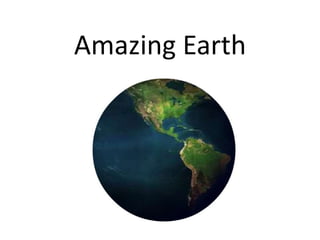
The Amazing Earth
- 2. Earth is the third planet from the Sun Can you name all of the planets? Earth is the largest of the 4 inner planets that orbit the sun.
- 3. Earth is almost a perfect sphere
- 4. One moon orbits the Earth It takes the moon about 28 days to orbit counterclockwise around the Earth.
- 5. The orbit around the sun is elliptical. As the Earth orbits the sun, the moon orbits the Earth.
- 6. Earth is tilted 23.5 degrees on its axis Axis - an imaginary line that goes through the center of the earth from the north pole to the south pole.
- 7. Earth is a unique planet It is the only planet in our Solar System that is known to have liquid water. It can be found in all three states.
- 8. Water vs. Land on Earth About 75% About 25% of Earth is covered in water of Earth is land (continents) Water versus Land Land Water
- 9. Only a small % of water is available for humans to use and consume
- 10. Earth has a blanket or layer of breathable air This is called the atmosphere.
- 11. The atmosphere is made up of the perfect mix of gases. Nitrogen 78% Oxygen 21% Other gases 1% Water vapor and dust particles are also found in the atmosphere.
- 12. The atmosphere is important to us for many reasons • Provides oxygen which all living things need to live
- 13. The atmosphere is important to us for many reasons • Provides oxygen which all living things need to live. • Protects us from most harmful UV rays from the sun
- 14. The atmosphere is important to us for many reasons • Provides oxygen which all living things need to live • Protects us from most harmful UV rays from the sun • Keeps the Earth at temperatures that aren’t too hot or too cold
- 15. The atmosphere is important to us for many reasons • Provides oxygen which all living things need to live. • Protects us from most harmful UV rays from the sun. • Keeps the Earth at temperatures that aren’t too hot or too cold • Protects us from meteorites which usually burn up as they hit the atmosphere
Hinweis der Redaktion
- Mercury, Venus, Earth and Mars are the inner planets. Jupiter, Saturn, Uranus, Neptune, and Pluto (dwarf planet) are the outer planets.
- Come See the Earth Turn book about the man who invented the pendulum (the earth rotating on its axis)
- Have each student put their finger on the map. Land or water. Tally. Should come up with a number almost equal to above numbers
- Water activity to show the amount of water available